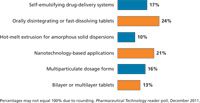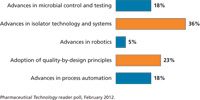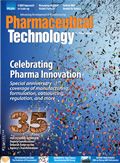News
Article
Pharmaceutical Technology
35th Anniversary Special: Reader Views on Changes in Pharmaceutical Manufacturing
Author(s):
Readers point to quality by design as having a significant influence on manufacturing and drug development during the past decade.
To gain a perspective on what have been the most significant changes affecting pharmaceutical development and manufacturing, Pharmaceutical Technology conducted a series of reader polls between December 2011 and May 2012 that asked our readers what they regarded as the most important changes affecting drug-substance and drug-product development and manufacturing during the past 10 years. The polls were directed in five main areas: small-molecule API manufacturing, biologic-based API manufacturing, solid dosage/oral drug delivery, sterile manufacturing, and analytical methods development and instrumentation (see Figures 1–5). Although individual technological advances were cited, an important theme throughout all the polls was the importance of quality by design (QbD).
The importance of quality by design
QbD came into prominence a decade ago when FDA announced a significant new initiative in August 2002, Pharmaceutical Current Good Manufacturing Practices (CGMPs) for the 21st Century (1). The initiative was intended to modernize FDA's regulation of pharmaceutical quality for drugs and select human biological products such as vaccines. The initiative evaluated the pharmaceutical as well as the chemistry, manufacturing, and controls (CMC) regulatory programs with the following specific goals:
- Encourage adoption of new technological advances
- Facilitate application of modern quality management techniques, including quality systems, to pharmaceutical production and quality assurance
- Encourage implementation of risk-based approaches
- Ensure that regulatory review, compliance, and inspection policies are based on modern pharmaceutical science
- Enhance the consistency and coordination of FDA's drug-quality regulatory programs, in part, by further integrating enhanced quality-systems approaches (1).
The science- and risk-based approach to pharmaceutical manufacturing that underpins quality by design has been furthered by subsequent guidance from FDA, EMA, and the International Conference on Harmonization. It is not surprising, therefore, that QbD was cited as a significant factor in reader polls.
Drug-substance manufacturing
When asked what was the most important change that has influenced chemical API development and manufacturing during the past 10 years, 61% of respondents cited QbD (see Figure 1). The significance of QbD far exceeded any single technological advancement in chemical API manufacturing, including microreactors, chemocatalysis, and biocatalysis.

Figure 1: What is the most important change that has influenced chemical API manufacturing during the past 10 years?
Readers also cited QbD as the most important change in biologic-based API manufacturing (see Figure 2) although its importance was more evenly matched with specific technology gains. Thirty percent cited QbD as the most significant change in biologic-based API manufacturing. Advancement of single-use technologies closely followed at 28%, and then improvements in upstream and downstream processing, each cited by 21% of readers polled.

Figure 2: What has been the most significant development in biologics-based drug development over the past 10 years?
Dosage form development, manufacturing, and analytical technology
We also asked readers to evaluate which technology has contributed the most to advancing oral product forms or oral drug delivery (see Figure 3). The two areas that received the highest responses were orally disintegrating tablet technology (24%) and nanotechnology-based applications (21%).

Figure 3: Which of the following breakthroughs has contributed the most to advancing oral drug delivery or oral product forms?
Advances in isolator technology and systems was cited as the most significant gain in sterile manufacturing, being cited by 36% of respondents, making it the highest ranked change in this area (see Figure 4). QbD followed at 23%.

Figure 4: During the past decade, what has been the most significant advance in sterile manufacturing?
Reflecting again the importance of QbD, 30% of respondents identified process analytical technology (PAT) as the most significant development in analytical methods development and instrumentation (see Figure 5). PAT tied with greater throughout in chromatographic methods as the most importance advance.

Figure 5: What would you identify as the most significant advance in analytical instrumentation and methods development during the past 5â10 years?
Looking ahead
We also asked readers to identify what they think will be the most significant change influencing the future of drug development and manufacturing (see Figure 6). More than one-third (36%) of respondents said the move to personalized medicine through the increased use of diagnostics with traditional pharmaceuticals. More than one-quarter (29%) said the rise of biologic-based drugs in drug pipelines and commercial product portfolios followed by fuller adoption of QbD (22%).

Figure 6: Looking forward 10 years from now, what do you think will be the most significant change in drug development and manufacturing?
Reference
1. FDA, Pharmaceutical CGMPs for the 21st Century—A Risk-Based Approach, Final Report (Rockville, MD, 2004).

Newsletter
Get the essential updates shaping the future of pharma manufacturing and compliance—subscribe today to Pharmaceutical Technology and never miss a breakthrough.





